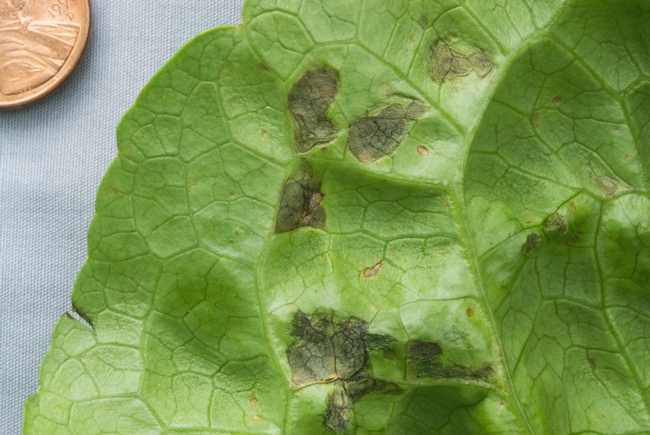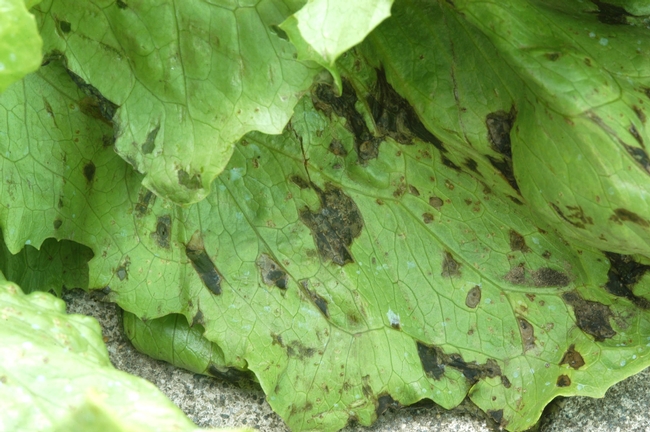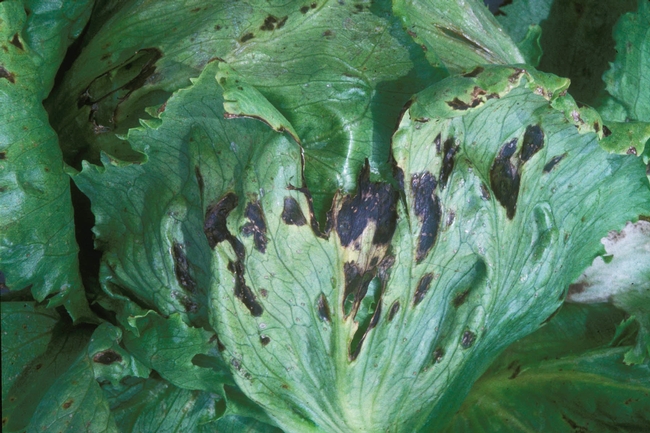Chronic problem. Bacterial leaf spot of lettuce has been affecting coastal California crops for many years and has become a chronic problem. The disease was first noted in California in 1964 and became an economic concern in the 1990s. Bacterial leaf spot now occurs to some degree every season. In addition, it is possible that new strains of the pathogen may cause disease in previously resistant lettuce cultivars. For these reasons researchers are continuing to study the problem and are now requesting samples from cases that occur in 2013.
Symptoms. Early symptoms of bacterial leaf spot are small (1/8 to 1/4 inch), water-soaked spots that usually occur only on the older, outer leaves of the plant. Lesions are typically angular in shape because the pathogen does not penetrate or cross the veins in the leaf. Lesions quickly turn black—this is the diagnostic feature of this disease. If disease is severe, numerous lesions may coalesce, resulting in the collapse of the leaf. Older lesions dry up and become papery in texture, but retain the black color. Lesions rarely occur on newly developing leaves. If disease is severe, secondary decay organisms (bacteria, Botrytis cinerea) can colonize the leaves and result in a messy soft rot of the plant. Bacterial leaf spot can occur on all types of lettuce: iceberg, romaine, leaf, and butterhead. See photos below.
Pathogen. Bacterial leaf spot is caused by Xanthomonas campestris pv. vitians. The taxonomy of this pathogen is unsettled and the name is likely to change in the next few years. This bacterium is a pathogen mostly limited to lettuce, though under greenhouse conditions several weeds in the same plant family can develop bacterial leaf spot disease when inoculated. We have not yet found naturally infected weeds showing leaf spot symptoms in the field. Some researchers indicate that X. campestris pv. vitians from lettuce can infect very different crops such as pepper and tomato when these plants are artificially inoculated; however, naturally infected pepper and tomato have never been found in California. Bacterial leaf spot disease of lettuce should not be confused with other Xanthomonas diseases. For example, bacterial spot disease of tomato and pepper is caused by a distinct pathovar (Xanthomonas campestris pv. vesicatoria); this pathogen will not infect lettuce. However, a related pathogen caused bacterial leaf spot on radicchio in California.
Disease cycle. The pathogen is highly dependent on wet, cool conditions for infection and disease development. Splashing water from overhead irrigation and rain disperses the pathogen in the field and enables the pathogen to infect significant numbers of plants. The pathogen can be seedborne, though the extent and frequency of seedborne inoculum is not currently known. If lettuce transplants are grown from infested seed, the pathogen may become established on plants during the greenhouse phase of growth. The bacterium can survive for up to five months in the soil. Therefore, infected lettuce plants and residues, once disked into the soil, can supply bacterial inoculum that can infect a subsequent lettuce planting. The bacterium has also been found surviving epiphytically on weed plants, though the significance of this factor is not known. In terms of time of year, a very consistent pattern of bacterial leaf spot outbreaks is documented for the Salinas Valley. There is almost an annual pattern in which severe bacterial leaf spot occurs in August and September. Researchers have not clearly documented why the disease consistently occurs at severe levels in this late summer period.
Control. Clearly the elimination or reduction of the use of overhead sprinkler irrigation will significantly curtail this disease in all situations, except when rains occur. Some resistant lettuce lines have been identified, though resistance is not widely available in currently used cultivars. Residual bacterial inoculum, left in the soil following an infected lettuce crop, will potentially cause problems for the next lettuce planting unless that planting is delayed for five months or longer. Therefore, crop rotation schemes will need to be evaluated if bacterial leaf spot is a chronic problem in fields heavily planted to lettuce. Effective foliar sprays have not been identified for this disease. Lettuce seed should be free of the pathogen.
Samples needed. Differences in pathogen genotypes have been demonstrated and correlated to disease responses on resistant and susceptible lettuce cultivars. In California the deployed lettuce germplasm is resistant to the strains of the pathogen collected many years ago in California. We therefore request samples of bacterial leaf spot disease so as to determine if novel, resistance-breaking strains are found in California. If you encounter this disease, samples can be submitted to the Cooperative Extension Diagnostic Lab in Salinas (1432 Abbott Street, Salinas).
Attached Images:


